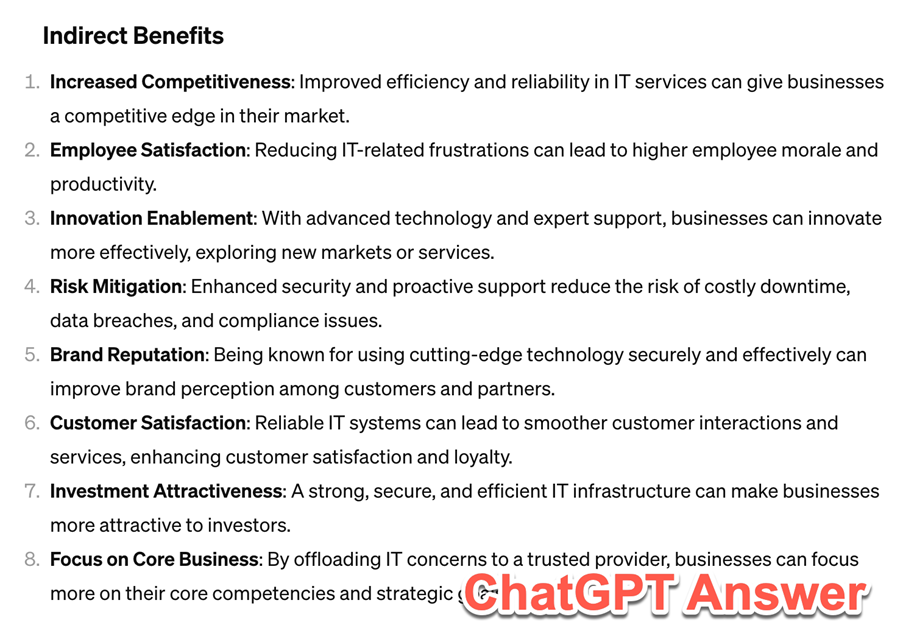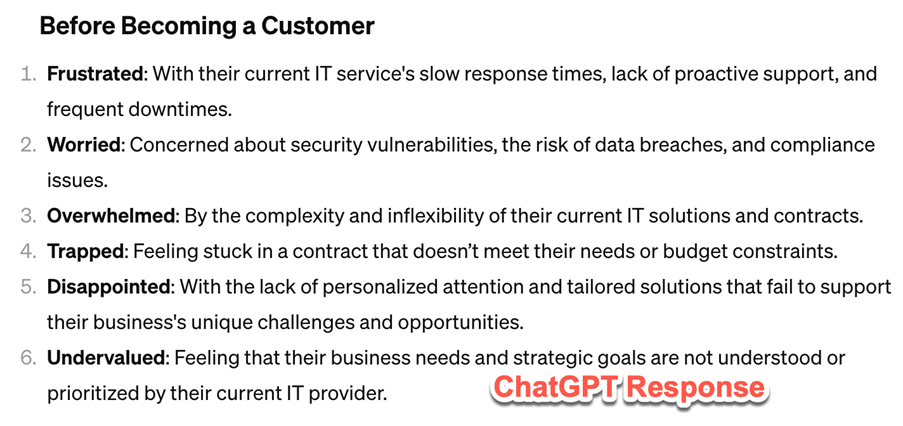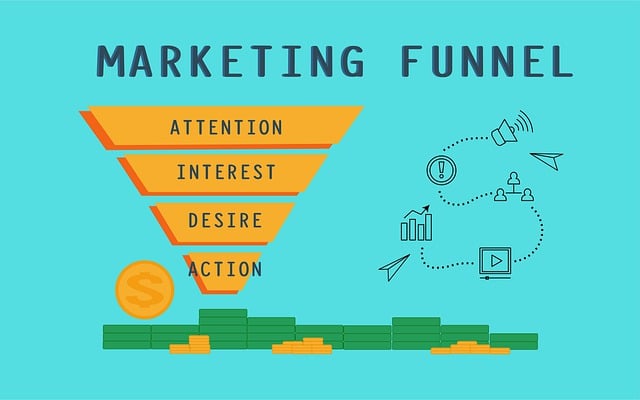Got a question for you. What does your marketing strategy look like?
Do you have one?
You might even be asking, why do I need a strategy?
A marketing strategy document sounds like a boring business activity, if you ask me – I thought that for many years. The word itself, “strategy”, I always thought was bandied around, paraded out by those that don’t do real work or might be part of an executive team.
A brown-nosing activity to keep the owner or CEO happy.
But I was wrong, and I’m going to detail to you why you need a strategy for your IT business, how to come up with your own strategy document, and how it will help you grow your business and acquire more customers, easier.
Best of all, the strategy document is one of the first steps for those that have promised themselves that they’re going to start working on the business instead of working in the business.
As an added bonus, I’m going to show you how we will use AI to assist with this so we don’t end up boring ourselves to death.
You’ll feel happier once this is complete.
Why you need a strategy for your IT business.

Let’s get down to brass tacks here – I’ve worked with over four hundred managed service providers in the past 5 years. One of the questions I always ask is what marketing they’ve done in the past and why they’ve decided to sign up for the free trial of IT Rockstars.
Having collated the common answers to these questions, one thing stands out to me – most of them are shopping around, trying different marketing tactics, looking for that silver bullet that will fill their calendar with sales appointments.
None of these IT businesses ever mention their strategy. Not even the ones that have gone through a big branding exercise and spent weeks, if not months, defining their brand.
To make matters worse, when I first started this journey of acting as a marketing consultant for a few of our members here at IT Rockstars, there was no clear scope of work.
You wouldn’t start out a Microsoft 365 migration without first detailing the scope of work and schedule of activities to the client, or would you?
I guess that probably depends on how confident you are and how many times you’ve done it – but that’s the point when it comes to marketing your technology business – you’ve probably had limited success (hence you're reading this), unlike those Microsoft 365 migrations that you can do in your sleep now.
This is why you need a strategy – for direction, otherwise, you’ll get lost in all the marketing tactics, new shiny toys, and silver bullet shopping.
To put this another way, you don’t have GPS or cell signal, and without a roadmap, you’ll be driving around in circles for some time before you find someone that may give you correct directions.
Your MSP marketing strategy document is a roadmap to more sales appointments – that you’ll create before you leave the house and go on your journey.
You’ll build your own route to success.
When you get lost, you can refer to the marketing strategy to get you back on track.
Building Our Marketing Strategy Document
We’re going to cheat a little here and use AI to help us build out the document – we need to train the AI (use your preferred LLM of choice) on our business. There are key questions we need to answer that will form our “giga prompt”.
The examples I give you from here on in will form the basis of our prompt, which I’ll share with you at the end of building out this strategy knowledge we need to train our AI chat.
Smart Objectives For Your MSP Marketing Strategy
Let’s start off with the goals & targets of the strategy – what we want to get out of marketing our business. In the form of a SMART objective:
Strategy Objective Example: The purpose of the marketing strategy is to generate 20 qualified leads per month from the target market within the next quarter. Of those 20 leads per month, it will equate to one new introductory appointment in the diary every week.
In this example, I’ve clearly defined a target metric and a timeframe I want to achieve that metric. This will be different for you – you might only be able to handle 1 “introductory appointment” per week, or you may have a dedicated salesperson in which case you’d be looking for 5 appointments per week. And if you want 5 appointments, the lead number has to increase.
Define Your Ideal MSP Customer Profile & Buyer Persona
This is the easy bit – who are your top customers? Which ones are easiest to work with and are the most profitable?
Which customers do your staff get on with and like servicing?
Which customers are you comfortable meeting with?
Is your key contact with the customers male or female, how old are they? What business and service do they provide?
How many users do they have?
Answer these questions with the top 3 customers
you have. That’s your ideal customer and buyer persona.
Here’s my example:
The ideal customer for IT Rockstars is male, aged between 35-55, owns and runs an IT business.
Has grown the business through word of mouth referrals but is now looking to scale. Based in the USA, UK, or Australia, and has a small team of 2-5 technicians and someone that performs admin duties. Spends his time both in technical work and running the business.
Married and has kids; due to these life circumstances, is serious about growing his business for the future of his family.
I’ll change this up in the prompt itself for our giga prompt example. Now take a moment and have a think about who your ideal customers are – get into the details if you can, even describing what they do in their spare time.
3 Unique Selling Proposition Examples And Why Not To Use Them
Next up, we’ve got to define how we will present our business in the copy and communications we push out as part of our marketing materials.
What type of work do you and your team enjoy and are good at? Be honest with yourself here. The history of your business and what you believe in all form what is commonly called your unique selling proposition.
Example 1
We help you achieve business goals using technology.
Example 2
We turn your IT and software costs into investments that make your business more profitable.
Example 3
We secure your systems and data to keep you compliant, accelerating investment readiness.
These three USP examples are common to the managed IT services space. Example one aligns with IT infrastructure, example two aligns with automation, and example three aligns with cybersecurity.
The question then is, what makes you unique? Is it your attention to details? Your service delivery? Your experience in supporting a particular line of business software? Or maybe it’s who you serve in the market? Maybe you exclusively only work with manufacturing firms that run a specialist piece of software?
Think deeply about the uniqueness, you won't believe how many times I hear the quip “our people make us unique”; that’s a poor USP, there’s no thought or effort in this. Everyone’s staff make them unique, and it’s not why a prospect would choose you over someone else.
A key ingredient to your USP should the benefit to your clients and the outcome.
If you provide a responsive helpdesk – how does that benefit the customer? What’s the outcome for them? They get more time in the day to get on with business instead of waiting for a phone call back from the help desk to restart a printer spool service.
In this example, we could build upon our first USP example:
“Spend less time dealing with technology; instead, we help you leverage it to achieve business goals”
Magnetic Attraction And Leveraging Pain Points With The Right Messaging
We next need to look at the pain points we’ll use in our copy to attract our ideal clients. Here’s some of the most common reasons a business seeks out a new IT provider – this info is based on discussions with our members here at IT Rockstars:
Pain point 1
Existing IT provider is too slow to react.
Pain point 2
We’ve had a security breach, and our backups failed.
Pain point 3
Existing provider lacks communication skills; we need someone that can align technology with our business needs and keep things clear to us.
Pain Point 4
Limited technical expertise – we’re expanding and have outgrown our current IT provider.
Pain Point 5
Current provider is not focused on cybersecurity – it’s a growing concern for us, and we’re seeing an increase in email phishing.
Pain Point 6
We need something tailored to our specific needs.
Pain Point 7
Lack of proactive IT support; always calling them with issues.
You’ll note from this list I’ve not touched on price – we don’t want to promote our business based on price – that’s a race to the bottom and attracts the wrong types of clients!
Benefit Driven Bullets
Next let’s focus on both the direct and indirect benefits of using our IT services. Remember in the marketing world we talk features and benefits – most of our marketing has to focus in on the benefits, features of your IT service like for example your fast response times are great but what’s the benefit of that feature to the potential customer?
Benefits of your service are what we want to include in our marketing content.
Sometimes it can be difficult to figure out what the benefits of your business actually are – that’s usually because you’re in the woods making sure all those features work as they should – you can’t see the forest (benefits) for the trees (features).
This is where we can use AI to get out our own head space and ask a simple question:

In this prompt I’ve been chatting about painpoints my potential customers have – the follow up reply I’ve asked as you can see if to list out all the benefits and here’s what I got back:


Pretty cool – this saves so much work and thinking – it could take a few people in a room brain storming for an hour to come up with these lists, but in only a few sections we’ve got some real ammo here we can use for our marketing communications and copy.
We can take this one step further though – as you might be aware if you are really good at sales – people take action based on emotional triggers.
I do this all the time when I’m creating marketing content – go into the details about how the lack of leads in your IT business makes you feel and how it made me feel when I ran my own business.
It sucked and I was not confident at the time I was “scratching around” looking for leads and the one or two a month I did get were not aware of what my MSP did at the time so when it came to the sales it was a long time before I closed deals (6 months on average). This made me feel lost and I was giving up hope.
This set of circumstances led to the creation of IT Rockstars – a company that helps MSPs transform they way they market their business, it was born out of the pain I had and as I’m aware many other MSP business owners have.
I use these emotion triggers to relate to my prospects. Let’s see what ChatGPT comes back with if we ask:

And here’s the response:


What KPIs to Track As Part Of Your Marketing Strategy
There are various key performance indicators we should be monitoring – we need to make sure we’ve got a baseline and a handle on how effective the marketing tactics we employ are having.
If something is working well, we can scale; if something is performing not so great, then we need to fix it.
Here’s the key stats I track as standard:
Website Visitors, this is basic and a must, use Google Analytics.
Website Impressions – this helps understand if you're doing things like SEO if it’s making a difference. Stats in regards to search impressions can be found in Google Search Console.
Traffic To Specific Pages – There will be some important pages on your website – one of these is your landing page or contact form – the page where users can take an action and book time in your diary. You want to be directing all your website visitors to this page and monitoring the performance of both the visits to the page and the actions that are performed on
the page. Google Analytics holds this data with the setup of a conversion goal for actions on the page.
Contact Count on CRM – how many leads from marketing funnels are filling in your lead gen forms, newsletter signs up, and event registrations; all of those contacts should be funneled into your CRM and scores kept on contact count over time.
Sales Appointments – this by far is the most important KPI when it comes to monitoring the effectiveness of your marketing campaigns. If you’ve not been monitoring what your monthly count is from starting your business, the best place to find this info is in your calendar – simply count the external “intro” meetings you’ve had.
Going forward, you’ll need to make sure you count where the sales appointment is coming from; in the marketing world, this is known as attribution – is it a referral, or is it a website visit? Keep track of this.
Marketing Processes
We’ve almost finished the strategy but there’s one thing we still need to do and that’s the delivery mechanism. The tactics we’ll employ to attract leads with to the right market with the right message using the correct media.
This is where the concept of the marketing funnel comes into play. The tactics we employ with fit at various stages of the marketing funnel:

The marketing processes is where the actual marketing takes place. We’ve come up with our pain point, benefits and our target market this allows up to get our messaging on point to the right
MSP Marketing Process Map
Process 1: Top Of Funnel Automated Lead Generation | |
|---|---|
Summary | Create an automated lead generation marketing campaign that is evergreen and requires minimal intervention over time. |
Candance | Evergreen |
Media | Paid Advertising (Meta Platform) |
Tools | CRM & Zapier |
Metrics | Ad Performance/Lead Per month/Conversion Rates |
Responsible | [Internal] Marketing Assistant |
Process 2: Middle Of Funnel Nurture | |
|---|---|
Summary | Educate and build trust with leads and online audiences. |
Candance | Daily, Weekly, Monthly |
Media | Social Media, Email Newsletter, Printed Newsletter. |
Tools | Canva/Missinglettr/CRM |
Metrics | Email Opens & Social Stats |
Responsible | Delegated to: Content Provider, Marketing Intern & Admin |
Process 3: Top of Funnel Inbound | |
|---|---|
Summary | MSP search engine optimization of website – both local keywords and industry relevant national keyword targets. |
Candance | Evergreen |
Media | Search Engines, Google/Bing etc. |
Tools | n/a |
Metrics | Google Search Console/Google Analytics |
Responsible | MSP SEO consultancy |
Process 4: Middle Of Funnel Events | |
|---|---|
Summary | Quarterly mix of both online webinars and offline lunch and learns. |
Candance | Quarterly |
Media | Social Media, Email/Print Newsletter |
Tools | PowerPoint/MS Teams/CRM |
Metrics | Event Registration/Event Attendance/Event Follow Up Meetings |
Responsible | Marketing Intern/Admin & Sales |
Building Your MSP Marketing Strategy Blueprint
We’ve covered a lot here – as promised we now need to build a strategy document you can refer back to give you direction when you and your team are feeling lost.
This is where we get AI involved – those business documents can be boring to write (I find them boring, maybe your different?)
I’ve used ChatGPT to write a series of business policies and it does have it’s place when creating content. Most already know that when it comes to writing content – it can be obvious that it’s AI generated but when it comes to these internal business document it doesn’t matter so much and we can do a bit of prompt engineering to make it fit our needs.
Here is prompt part 1 of 2:
You have to date sold many businesses, a veteran when it comes to growing and selling businesses. As part of this and due diligence that’s preformed on a company we want to build a marketing strategy document for our business.
It has two goals – to help align what we are doing for a marketing perspective but also if we seek investment or plan to sell will be a solid document that is investor ready.
I would like to give you some information on our business, our ideal client and some of the marketing processes we plan to employ – you this as a basis of writing the strategy document.
Prompt 2 of 2:
The name of the business is [company name], we are a [enter employee size], based in [location]. We provide IT support, cyber security and managed IT services.
We work primarily with [enter industries].
Our unique selling point to these types of businesses is our [enter USP]
Pinpoints on why customers switch I are usually related to [most common switch provider reason you encounter]
Here are a list or marketing processes we plan to implement:
[marketing processes]
---END PROMPT---
Conclusion
The prompt output is bulleted – reads well and give a clear, concise MSP marketing strategy outline.
This is obviously an example but you can use this as your needs see fit.
My key takeaways since you’ve read this far is having the document written will make it more of a reality. I speak with managed IT service providers every week.
They tell me about their previous marketing strategies, tactics and experiences. Some great stories but what rings true with many of them is having no formal document they are using to help guide them on the actions they have to take.
If there’s one thing that I suggest you do is use this as an introduction to the first person you hire to help with marketing. This will give them a good grounding on what might have been up in your head for years but is now down on paper.